Abstract
The problem of sustainability of energy production in the context of the expansion of renewable energy cannot be solved without a deep technological modernization of the fossil fuels extraction in line with Industry 4.0. Along with this, the expected transition to the human-centric Industry 5.0 raises the question for researchers: what core technologies of the Mining 4.0 platform will determine its transformation into Mining 5.0 in order to meet the imperative of sustainable development and the dominance of green energy. This review presents a multifaceted overview of Mining 4.0 core technologies, derived from Industry 4.0, such as smart sensors, neural networks, Big Data analytics, Internet of Things, digital twins and artificial intelligence, that form cyber-physical systems for high-performance and complete extraction of fossil energy sources. The review of works in the field of transition to Industry 5.0 is associated with Mining 5.0 core technologies—Cloud Mining, post-mining, biochemical extraction of minerals and production of green hydrogen fuel from fossil hydrocarbons, which is expected after 2050. A conclusion is made about the need for a deep analysis of harmonizing the possibilities for the innovative development of fossil fuel sources and renewable energy for sustainable energy production in the upcoming decades.
1. Introduction
Today, the foundation is being laid for reducing the use of fossil fuels in the coming decades, largely due to the expansion of renewable energy and the diffusion of breakthrough technologies of Industry 4.0 (Energy 4.0). Therefore, the fossil energy sector must undergo a profound technological transformation, which is backed up by the need for a deficit-free energy supply for future generations.
The concept of Industry 4.0 reflects a new round of automation using modern digital intelligent technologies that allow “seamless” optimization and harmonization of both individual processes and the entire production as a whole. In fossil fuels extraction, the application of Industry 4.0 is aimed primarily at reducing human intervention for a radical increase in labor safety productivity, as well as for lean and flexible mining.
In turn, the concept of transition to Industry 5.0 is determined by the objective need to turn the industry towards society’s demand for a sustainable supply of goods, services and energy, while preserving nature, extending life and improving its quality. The benefits of Industry 5.0 for sustainable energy production lie in the management and optimization of fossil fuels mining and burning in the volumes required to balance renewable and traditional energy without its deficit in conditions of growing demand for it.
The main objective of this review is identifying Industry 4.0 technologies that, as they become the core of Industry 5.0 in the future, will determine the success of the transition to sustainable energy and show their role in ensuring the long-term participation of fossil fuels in this process in harmony with renewable energy.
The difference between Industry 4.0 and 5.0 lies in the redirection of the wave of digital industrial innovation towards goals of human-centered sustainability. The innovations that emerged during the fourth industrial revolution—the Internet of Things, artificial intelligence, cyber-physical systems, “smart” robots and self-optimizing systems, Big Data exchange and analytics, etc.—are transformed in Industry 5.0’s environment into “innovations for the benefit of man and nature” [1]. The key factors in the transition from Industry 4.0 to 5.0 are the following [2]:
- -
- The expansion of digital twins of physical systems, which radically increase the productivity of large production chains;
- -
- Reliance on artificial intelligence in predicting and preventing equipment failures and danger conditions;
- -
- Iterative simulation of the approaches in generative design using machine learning;
- -
- Replacement of people—machine operators—by managers of collaborative robots;
- -
- Transition from company to industry forecasting and coordination based on machine learning.
The transition from Industry 4.0 to Industry 5.0—from a purely digital platform to a human-centered one—is associated with the transformation of the processes of extraction of fossil fuels and the production of thermal energy in the form of their integration into the system of a recycling economy. In it, the spread of Industry 4.0 technologies into mineral-extracting and power-producing sectors is based on the effects of machine-to-machine communications, smart sensing, smart supply chains and technological convergence [3]. This gives traditional thermal energy, produced from renewable fossil fuels, a certain parity with renewable energy [4].
It should be noted that in the current era of Industry 4.0, the foundation was already laid for preventing crises on the power market and technogenic disasters, as well as environmental damage, thanks to the transition to an integrated technological platform for mining, thermal and renewable energy, as well as environmental protection [5]. The development of such a platform is fully consistent with the imperative of the Fifth Industrial Revolution, in which digital technologies will serve the well-being of individuals and the whole society, largely related to the environmentally safe production of energy and energy sources [6].
At the same time, the extraction of fossil energy sources will also inevitably go through the integration of people and machines into the human-centered innovative environment of Industry 5.0, which is characterized by the following [7]:
- -
- Integration of human and machine activities into “augmented” labor—creative, intuitively determined, without excessive automation;
- -
- Formation of flexible and distributed chains for the production of energy sources and their burning in accordance with the need for energy and the increase in energy saving;
- -
- Elimination of labor safety risks.
In accordance with the principles of the European Commission, six key areas for the development of Industry 5.0 have been identified: Big Data, digital twins, technologies for the energy-efficient use of renewable and autonomous energy sources, individual human–machine interaction, biotechnology and neural link [8].
Such advanced digital technologies can be fully attributed to the development of energy production from fossil fuels in the context of the transition to sustainable development [9]. An important place in the optimization of this industry sector is given to reducing the amount of waste in the design of combined energy systems, including renewable and non-renewable ones, during the introduction of artificial intelligence and collaborative robots (cobots) [10]. This idea has already come close to the largest cities in the world—the most important consumers of energy. This is of particular importance for China, which has a high share of energy production from fossil fuels [11].
In general, the key technologies of Industry 5.0 are considered as a part of the process of transition to Society 5.0—the fulfillment of society’s demand for sustainable development and uninterrupted energy supply through the integration of physical and cyber space (Figure 1).
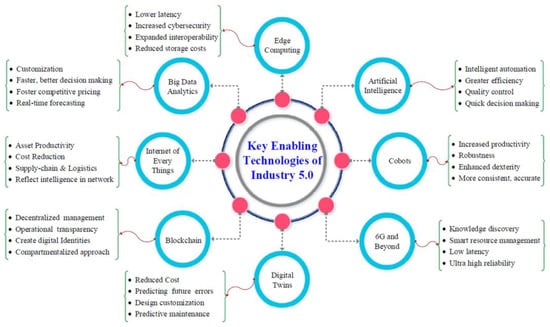
Figure 1.
Key technologies of Industry 5.0 (taken from Ref. [12]).
In Industry 5.0, human value-driven initiatives (Table 1) aim to bring end-to-end technologies to all industries, including core ones related to the extraction of fossil fuels, and human–robot collaboration. This helps to reduce the amount of industrial waste and emissions into the environment, minimize the wear and tear of physical systems with the help of digital twins and enhance the creative component of engineering work through virtual reality [13].

Table 1.
Overview of global technology initiatives (taken from Ref. [14]).
In the initiatives presented above for the diffusion of Industry 5.0 in basic industries, the so-called Super-Smart Society concept should be especially noted as Society 5.0. In essence, Society 5.0 aims to create a common infrastructure for prosperity based on an advanced platform of digital industrial, financial and social services, while Industry 4.0 is focused on production and has little to do with increased social responsibility and movement towards sustainable development [15].
The study of co-existence of different types of power production in Industry 4.0 and 5.0, conducted by S. Zeb, A. Mahmood, S.A. Khowaja et al., is of increasing interest for authors around the world (Figure 2, data on the number of articles are given in square brackets).
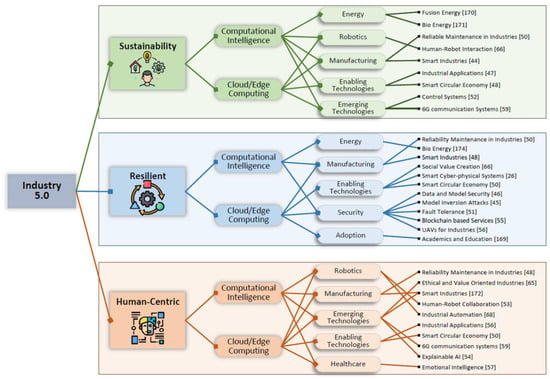
Figure 2.
The place of energy transition under the influence of Industry 5.0 in scientific publications (taken from Ref. [16]).
The social aspect of the transition to Industry 4.0 and further to 5.0 is directly related to the efficient use of energy and fossil fuels. Here, a dilemma arises: digital technologies, on the one hand, require an increase in energy production, and on the other hand, they save energy. Therefore, the process of selecting the best technologies for Energy and Mining 4.0 and 5.0 should include environmental and social criteria for sustainable development that do not absolutize productivity growth [17].
2. Methodology
All the research papers presented in this review belong to the area of Mining 4.0–5.0 technologies, with an analysis of the sectoral specifics of their implementation and their benefits that mining sector receives in the context of the expansion of Industry 4.0. This review aims to analyze the structure and temporal distribution of the published results of research of Mining 4.0 platforms in relation to the imperatives of sustainable development and zero-deficit energy supply established by Energy 4.0, as well as the human centricity of Industry 5.0, in order to expand it in the future.
This review is designed in the spirit of constructive critical analysis of research and scientific and publicized works. This allowed comparing the advantages and limitations of Mining 4.0′s core technologies and thereby pushes today’s future researchers to rethink the importance of accelerating the transition to Mining 5.0 in the face of fluctuating demand on fossil fuels and their nebulous future.
The research strategy includes the following: formulating its hypothesis; analysis of work in the field of the core of Mining 4.0 and Energy 4.0, the needs and conditions for the transition to Mining 5.0 and Energy 5.0; conceptualization of the participation of fossil fuels in this process as a factor of sustainable energy development.
Research hypothesis: the expected transition to sustainable energy (Energy 5.0) within Industry 5.0 is impossible without the technological transformation of fossil fuels extraction from Mining 4.0 to 5.0, which ensures the harmonious development of traditional and renewable energy.
The purpose of this review is to analyze, structure and summarize the authors’ conclusions and achievements in the field of implementation of Mining 4.0 technologies in the context of the transition of the energy sector to the Energy 4.0 platform, built on Industry 4.0 end-to-end technologies, taking into account the prospects for Mining 5.0 onset in upcoming future.
This review’s tasks are the following: determination of the areas of main interest to researchers of Industry 4.0 in mineral sources extraction, identification of significant trends and “bottlenecks” in the system of transition to Mining 5.0 with its human centricity and sustainable development.
According to the goal and tasks, we divided this review into five sections.
Section 1 “Introduction” shows the foundation of the innovative development of fossil fuels extraction in the context of the deployment of the Fourth Industrial Revolution, and the prospects for the transition to Society and Industry 5.0 are considered.
Section 2 “Methodology” provides a description of the research issues and a quantitative review of considered publications.
Section 3 “Mining 4.0 technological core” contains descriptions of Industry 4.0 digital technologies diffusion in minerals extraction, paying special attention to fossil fuels production.
Section 4 “Place of Mining 4.0 and 5.0 in the Expected Expansion of Industry 5.0” provides an overview of the trend and drivers of deep modernization of the minerals extraction sector due to the transition to the dominance of renewable energy and human-centric production. In addition, an analysis of technologies of Mining 4.0’s platform core, which determines the perspective of Mining 5.0, is given.
Section 5 “Technological platform for the transition from Mining and Energy 4.0 to 5.0” is devoted to the development of the most promising digital technologies—the Internet of Energy, deep learning and smart grids.
Section 6 “Human-Oriented Core of Mining 5.0” contains an analysis of the specifics of Mining 5.0 in relation to Mining 4.0 and 3.0 and discusses the prospects for innovative development of green mining of fossil energy and the production of green energy.
Section 7 “Conclusions and Prospects” is devoted to summarizing the authors’ conclusions, identifying limitations and future directions for Mining 4.0 and 5.0 research.
During the bibliographic search within this review, such databases as Google Scholar, GeoRef, Springer Link, Science Direct, Clarivate (Web of Science) platform and Elsevier Scopus were used.
The priority publishing houses for the analysis of research papers were MDPI (Energies, Applied Sciences, Sensors, etc., journals), Springer, Elsevier, EDP Sciences (E3S Web of Conferences, etc.) and IOP Publishing (IOP Conferences Series).
As the keywords, the following were separately used: Industry 4.0, Industry 5.0, Mining 4.0, Mining 5.0, Energy 4.0, Energy 05, Internet of Things, Big Data, Cloud Mining, blockchain, fossil energy sources, digital twins, artificial intelligence, neural links, smart sensors, interactive modeling, machine vision and post-mining.
Figure 3 shows the distribution of scientific publications selected by these keywords by years.
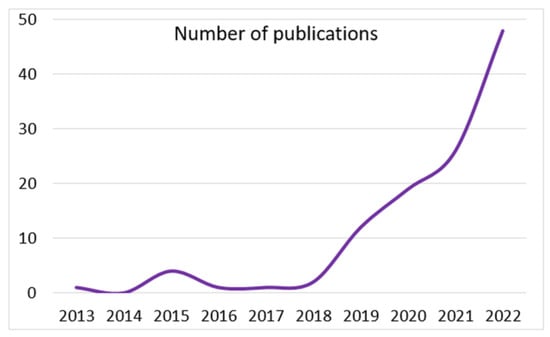
Figure 3.
The distribution of scientific publications on Mining 4.0 and 5.0 core technologies by years.
The data in Figure 3 show a sharp increase in the interest of researchers in the issues of Mining 4.0 and 5.0 since 2019, especially since 2021. That allows us to hope for the future accelerated development of core technologies of the platform with the transition to green mining and the production of clean energy from fossil fuels, along with the dominance of renewable energy in the future. The distribution of articles observed in this review by areas of Mining 4.0 and 5.0 core technologies is given in Figure 4.
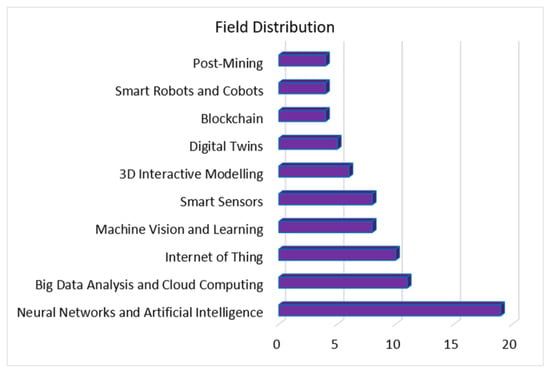
Figure 4.
The distribution of scientific publications by Mining 4.0 and 5.0 core areas.
As seen in Figure 4, most of the articles analyzed in this review are devoted to Big Data and cloud computing (including Cloud Mining), neural networks and artificial intelligence and Internet of Things (including Internet of Energy). In other areas, such as smart sensors, 3D modeling, digital twins, cobots and post-mining, the attention of researchers is rather scattered. Therefore, the development of research activity in these areas should be intensified in light of the expansion of Mining 4.0 and further movement towards Mining 5.0.
3. Mining 4.0 Technological Core
Expectations for digital-driven technological chains and their equipment in the mineral extraction sector by 2030 took shape as early as 2009, when Mining 3.0 was the dominant technological platform [18]. The digital transformation that forms the core of Mining 4.0 will make it possible to switch to a fundamentally new process and operations management system, which involves ultra-high-performance equipment, and to build a bridge to Mining 5.0 through the convergence of not individual technologies but man and machine [19]. The Internet of Things and cyber-physical systems take the main place in the system of fossil fuels production control, which allows resolving the contradiction between an increase in the productivity of the labor and reaching a new level of its safety [20]. Along with this, the digital basis of Mining 4.0 is integral to ensuring the cybersecurity of mining enterprises—secure data exchange when sharing cloud computing resources and preventing cyber-attacks. The segmentation of the diffusion of Industry 4.0 technologies into the mineral resource complex, as a result of which Mining 4.0 is being formed in practice, is shown in Figure 5.
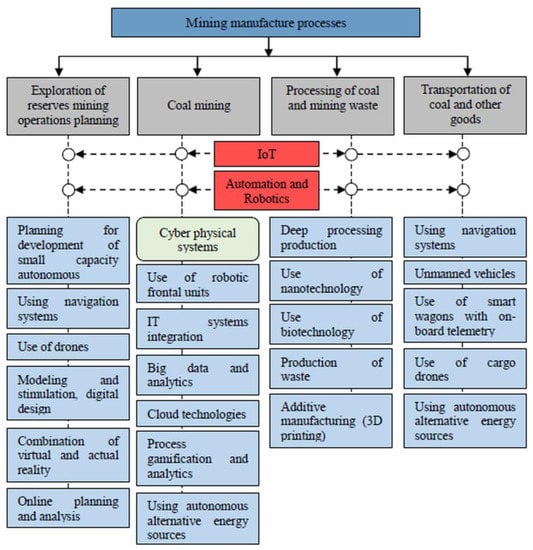
Figure 5.
Mining 4.0 main zones of Industry 4.0 diffusion in mining industry (taken from Ref. [21]).
Industry 4.0 technologies diffusion in all segments of Mining 4.0 is the transition to Computer Integrated Mining, the essence of which is to connect digital control systems for surface and underground mines and enrich mineral raw materials, primarily fossil energy sources, to the level of environmental safety, corresponding to Energy 4.0 and in the future 5.0. As a result, unified IT systems of mining enterprises and the industry as a whole are being formed, in which there will be no “gray” digitalization zones [22].
3.1. Computer Integrated Mining
In the digital ecosystem of Computer Integrated Mining (CIM), an end-to-end path of transition from Mining 3.0 to Mining 4.0 and 5.0 is being laid. It is associated with a change in the role of a person—a “miner of the future”, which, in fact, is an Operator 4.0 with new competencies, typical for cyber-physical systems. Such competencies include the use of biomechanical support and integration of the digital and physical world in augmented reality and the use of smart sensors, collaborative robots and Big Data analytics [23]. For example, it is expected that “miners of the future” will be able to actively receive online assistance from engineering service workers through interactive VR glasses, transmit information about the environment to the employees and receive information about the physical condition from them [24].
An example of CIM implementation is shown in Figure 6.
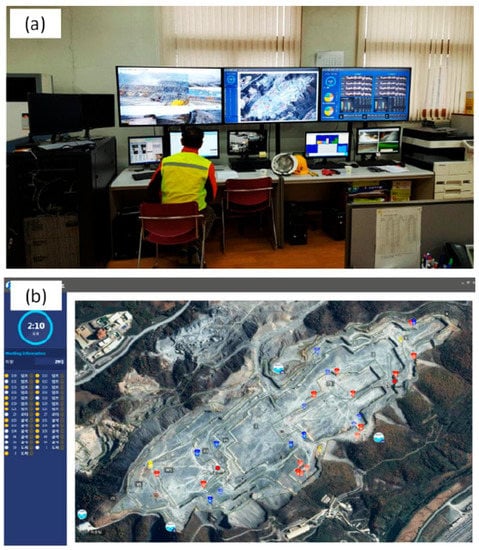
Figure 6.
Example of Computer Integrated Mining in South Korea surface mine: (a) control center; (b) virtual interactive dashboard (taken from Ref. [25]).
In general, the impact of Computer Integrated Mining on fossil fuels extraction is connected with the creation of a unified digital environment to increase productivity and human safety in all mining processes, which is important for smoothing fluctuations in energy markets—conditions for sustainable long-term attractiveness of investments in both traditional and renewable energy.
3.2. The Internet of Things
Due to the introduction of the most promising technology of Mining 4.0—the Internet of Things—removing a person from harmful and dangerous mining conditions is possible by equipping mining machines with smart sensors connected to online data centers and Big Data analysis systems [26].
Since the Internet of Things in Mining 4.0 is closely connected with the Internet of Energy in Energy 4.0, new principles of the architecture of the energy network of mining enterprises, which include electric drives of high power density, are being formed. These principles include plug-and-play, co-directional energy flows and information about its consumption, the integration of energy from renewable and non-renewable sources, the transfer of confidential information about the inspection of enterprises based on the network and the development of machine-to-machine interaction to reduce energy consumption [27]. In turn, the use of the Internet of Things to monitor the state of mining equipment is possible in real time [28]. In general, the use of the Internet of Things in Mining 4.0 is quite multifaceted and goes beyond the interaction of machines with each other and with operators (Figure 7).
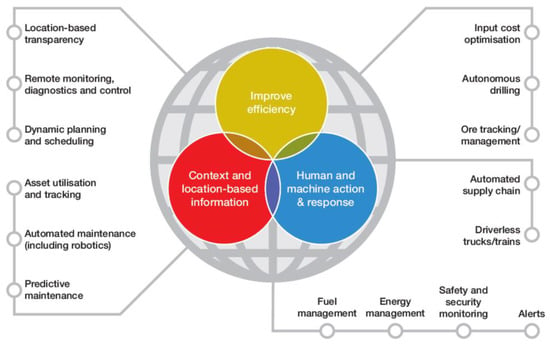
Figure 7.
The options of Internet-connected relations between nodes of a Mining 4.0 system (taken from Ref. [29]).
Examples of Internet of Things implementation in mining companies are shown in Figure 8.
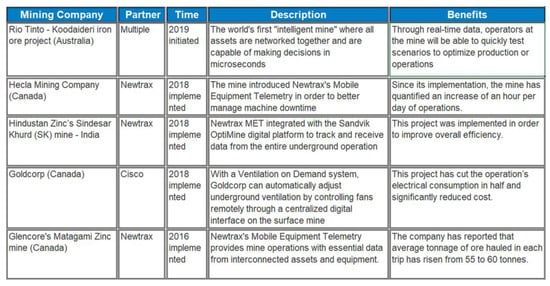
Figure 8.
Examples of Internet of Things implementation in the mining industry (reprinted from Ref. [30]).
The impact of the Internet of Things on the processes of extracting minerals is associated with the prospect of the complete removal of a person from dangerous and harmful mining conditions, with a decrease in the risk of equipment failures and accidents. In relation to sustainable development, the projection of the Internet of Things on the power industry means development of the Internet of Energy, which is the key to radical energy saving in industry, opening the way to reducing the need for energy from fossil sources.
3.3. Digital Twins
Another core technology of Mining 4.0—digital twins—is also a cyber-physical system that allows overcoming the limitations of the unequal speed of processing and transmitting information in various digital devices (mobile phones, laptops, mining equipment controllers, etc.) and radically increasing the productivity of the entire chain of mineral mining and processing due to asynchronous software requirements [31]. Dynamically developing links between Mining 4.0 and Energy 4.0 platforms within the same enterprise makes it possible to overcome the performance limitations associated with the different computing power of equipment when processing large amounts of information, which requires digital twins [32]. Due to the asynchronous functioning of various software and hardware systems at a mining enterprise, the linear organization of mining processes turns into a multi-link network in which different connected users control processes in real time (Figure 9).
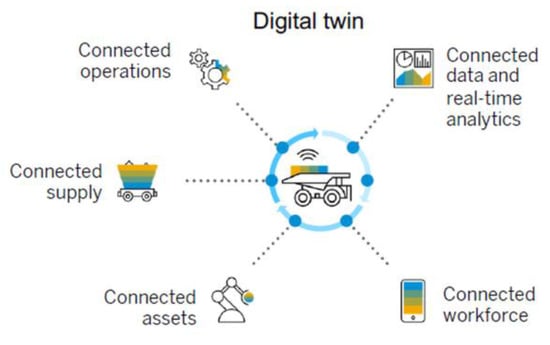
Figure 9.
Digital twins in Mining 4.0 (taken from Ref. [33]).
An example of creating a digital twin in mining (Apromore Company, Carlton, Australia) is shown in Figure 10.
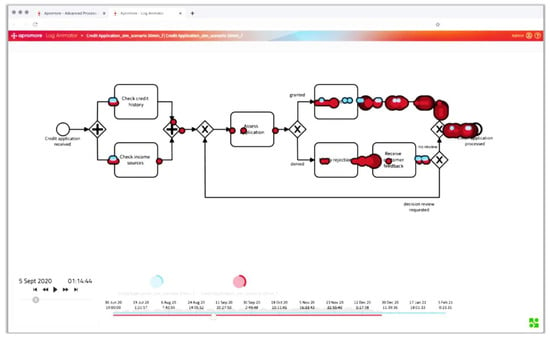
Figure 10.
Digital twin sample (Apromore Company, taken from Ref. [34]).
The influence of digital twins on fossil fuels mining and burning in power plants is to create a single digital environment for human interaction with various machine interfaces created using different software and transmitted using different devices. In the future, such a digital environment will allow for the combination of planning and controlling traditional energy production along its entire chain—from extraction to combustion of fossil energy carriers—and will eliminate their excess extraction while preserving the environment.
3.4. Big Data and Cloud Computing
Big Data and cloud computing are core technologies, defining a frontier of the change from Mining 4.0 to Mining 5.0. A distinctive feature of Big Data analysis is the ability to create new knowledge (Data Mining [35]), which gives a secondary impetus to the development of artificial intelligence and machine learning [36].
In turn, their modern capabilities allow the capabilities of individual mining equipment and the complex as a whole to merge into a single system for monitoring performance and uninterrupted operation, the reserve of which reaches 30% under the condition of deep digitalization [37]. The use of cloud computing in the diffusion of Mining 4.0 technologies in “intelligent” geological exploration makes it possible to create interactive conceptual models of large multidimensional data. Their use can radically improve the quality of a mineral while reducing the unit costs of its production [38], which will become especially relevant in the future (2060–70s) during the transition to the development of many depleted deposits located at a great depth [39]. Today, without relying on cloud computing, it is impossible to carry out full-scale interactive modeling of underground mines and structures, to position various objects in them more accurately and to predict sudden outbursts of gas and rock into workings. The analysis of a large number of points in the numerical modeling of underground mine workings is in demand not only on Earth but also in the prospect of mining on other planets during the exploration of the nearest space (Figure 11).

Figure 11.
Using a point cloud to model a segment of an underground facility on the Moon: (a) outside view of the tunnel; (b) inside view along the tunnel (taken from Ref. [40]).
The impact of Big Data analytics on fossil fuels extraction consists of expanding capabilities of integration of geological, geotechnical, design and process management data in a single information system of the mining enterprise, cluster and even sector. Such a high level of fossil fuels mining and burning processes integration based on Big Data analysis contributes to a sustainable supply of traditional energy and the whole stability of future energy systems. In its turn, cloud computing development creates a technical foundation for Big Data analytics, uniting a myriad of computers and companies’ data centers with ultimate power.
3.5. Smart Sensors
Smart sensors are the elements of another core technology of Mining 4.0, which is developing along with the Internet of Things. They allow receiving, processing and embedding various information about the state of people, equipment and the rock array into interactive models, accelerating the creation of information by machines and its readiness for people to make engineering decisions [41]. The autonomous intelligent monitoring system for mine conveyors (Belt 4.0) allows predicting the critical wear of their nodes and preventing the conveyor from stopping, as well as optimizing its loading [42] (Figure 12).
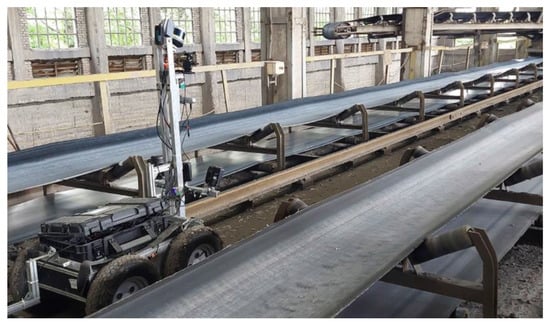
Figure 12.
Robot inspector checks the operation of the mine conveyor (taken from Ref. [43]).
The use of smart sensors in improving mine ventilation allows for visualizing the airflows with high accuracy. As a result, there was an increase in the efficiency of mine workings’ ventilation, including in emergency conditions, which fully correlates with the concept of human-centric Mining 5.0. Technically, the problem solution of modeling mine ventilation using smart sensors was tested at the enterprise of Junmei Corporation Ltd., Shanghai, China, where, in order to achieve the required accuracy of modeling, a third of the mine workings were equipped with more than 200 sensors [44]. It is important to increase labor safety by using smart gas sensors, which are attached to workers’ uniforms and to the walls in mine workings [45].
The human centricity of the development of the mineral resource sector, which is laid down at the stage of Mining 4.0 development, is largely determined by the reduction in the mining operations’ negative impact on third parties. In particular, it concerns timely prediction and prevention of subsidence of the surface over old and new tunnels.
For this purpose, the analysis of the point cloud from the Differential Interferometric Synthetic Aperture Radar (in the Big Data format) has proven itself well for an ultra-precise assessment of changes in the surface subsidence rate, lead angles and residual deformation along various axes [46]. The use of Differential Radar Interferometry to create interactive maps of earth deformation predictions above operating mines gives an unprecedented accuracy of 0.04 m [47]. With similar accuracy, the use of Interferometric Synthetic Aperture Radar predicts the deformation of the mine’s tunnels caused by the movement of rock arrays [48].
In turn, forecasting of man-made earthquakes requires ultra-high accuracy in predicting the displacement of underground rock blocks in the zone of intensive underground mining. Therefore, an important way to develop smart sensors can be recognized as increasing the preciousness of measurements of Deformation Decomposition of Persistent Scatterer Interferometry using the sequential creation of images by SAR Single Look Complex (SLC), considering the bands of the interferogram (modeling error is reduced by 35.2%) [49]. At surface mining sites, modern ground-penetrating radars are also smart sensors that control the movement of rock mass particles in the submillimeter range. In particular, the connection of the data from receivers of the Global Navigation Satellite System and the synchronizer pulse per second [50] gives higher accuracy.
The significance of smart sensors for fossil fuels extraction is defined as empowering mining machines with the ability to fully perceive the environment and make adequate decisions based on artificial intelligence. This, in turn, will maximize their reliability, labor safety, reduce the consumption of resources for repairs and bring the whole mining sector closer to the full extraction of minerals—an important component of sustainable development.
3.6. Three-Dimensional Scanning and Modeling
Three-dimensional scanning and virtual modeling of surface and underground mining is an important application of machine learning technologies. Full extraction of minerals, corresponding to the idea of Energy 4.0, requires, firstly, the reconstruction of partially developed deposits to ensure their safety using modern equipment, which is achievable using 3D laser scanning and modeling in the CAD/MBS system, for example, to avoid collisions of vehicles and equipment (Figure 13).
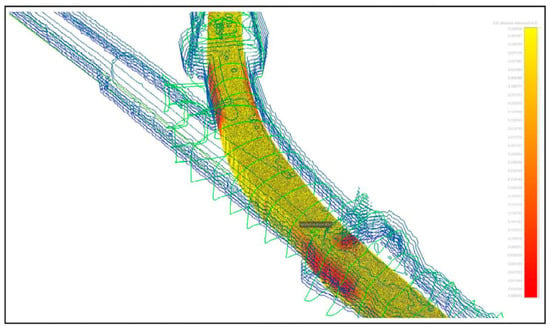
Figure 13.
Three-dimensional virtual model for analyzing the possibility of collisions in mine workings (green line—roof support; navy blue line—final contours of workings; blue line—rock transportation) (taken from Ref. [51]).
The use of Computational Fluid Dynamics and Computer-Added Design methods in 3D modeling of mine workings allows imbedding machine learning in the new interactive modeling cycles. They can detect even millimeter displacements of mine workings. The geometric model of a part of the mine workings, obtained using Computational Fluid Dynamics and Computer-Added Design in several iterations, is shown in Figure 14.
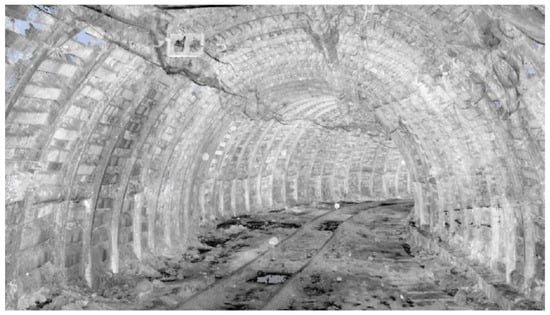
Figure 14.
Point cloud at the bend of a digitized mine working (taken from Ref. [52]).
With regard to the modeling of mineral deposits with complex contours, the need for the development of which is determined by full extraction, the creation of fairly simple geometric models based on geological data is used. This does not allow ensuring the required quality of the mineral, which becomes critical, for example, for complex structural coal deposits, where the ash content of coal during combustion at power plants determines the atmosphere pollution. A significant increase in the accuracy of the interactive 3D formation model is facilitated by such methods as the integration of geological exploration data, magnetic surveys and multispectral images obtained from drones in analytics [53], as well as a Hermite Radial Basis Function with spatial interpolation [54].
The extraction of minerals in underwater conditions, in particular, natural gas, will gradually affect coal mining as well [55]. The design of underground mine workings under water requires taking into account hard pressure and high fluid resistance in 3D modeling. Integrated use of OrcaFlex and Tracsim tools and Computational Fluid Dynamics is primarily aimed at modeling the mechanics of motion and the work of underwater smart robots in soils with various physical, technical and mechanical properties [56].
Interactive digital simulation of the operation of mining equipment makes it possible not only to increase its reliability and uninterrupted operation in an unprecedented way but also to protect operators from the effects of harmful and dangerous factors, such as vibration. Reducing the impact of vibration is possible at the stage of designing machines as a whole and their units using dynamic 3D models of the transmission of vibrations between them [57].
The role of 3D scanning and modeling in upgrading fossil fuels extraction to Mining 4.0 is to create a long-term foundation for the transition of geological exploration and mine surveying, technological processes and designing new deposits under the control of artificial intelligence, in the course of creating interactive and adaptive digital models. This will allow mining to be combined with the generation of energy needed for a sustainable power supply.
3.7. Blockchain
Blockchain technology in Mining 4.0 is developing towards the movement of information between block chains in a distributed network covering not one sector (which is typical for finance and cryptocurrencies) but several sectors and related industries (mining, enrichment and burning in thermal power plants, as well as integrated management of renewable and non-renewable energy [58]). As a result, an intersectoral ecosystem is formed based on a distributed network of the “cross-chain” type, in which the data from separate sensors can be broadcast to all stakeholders, with the intensification of the data exchange. Further, the expected expansion of using the blockchain in the mineral and energy sectors will be based on distributed smart contracts that form a transparent energy system [59].
Another application of blockchain technology in the extraction of fossil energy resources is associated with the inspection of mining companies’ operations, assets and ensuring labor safety. The use of distributed data storage allows making the mining inspection as impartial as possible, due to the fact that equipment manufacturers, company owners, authorities and mining inspectors will interact on the basis of advanced digital architecture, including the blockchain, mobile applications with digital twins and cloud computing modules, as well as connected peripheral devices (Figure 15).
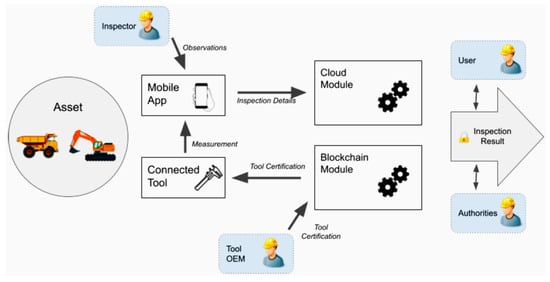
Figure 15.
The system of integration of blockchain technologies and digital twins in the information support of mine inspection (taken from Ref. [60]).
Blockchain-distributed computing technologies give a new impetus to high-accuracy prediction of methane concentration in coal mines in real time, in particular when jointly using such models and software as support vector machine, Autoregressive Integrated Moving Average and Spark Streaming when building a new SPARS forecasting, which has positively proven itself in the analysis of COVID-19 waves [61]. As a result, there is a unique opportunity to quickly process large batches of streaming data, sufficient for taking quick measures to reduce the concentration of methane without human intervention, with the help of artificial intelligence.
Thus, the application of the blockchain in fossil fuels mining and burning in power production provides a unique opportunity for super-reliable data exchange between various participants in energy production, both traditional and renewable, as well as between mining inspectors, engineers, workers and managers. This accelerates the achievement of UN Sustainable Development Goals 3 and 7: good health and well-being and affordable and clean energy.
3.8. Neural Networks
The place of neural networks in the platform of Mining 4.0 is determined by the ever-increasing links between the energy efficiency of the mining sector and the share of fossil fuels in the energy balance of individual countries and the whole world. To model these relationships in the search for the optimum use of fossil and renewable energy sources, the role of neural networks cannot be overestimated [62,63]. They are tasked with solving a mixed-integer linear programming problem with the use of large computing power, in the course of a phased iterative selection of combinations of the values of the resources expended and the energy produced using the branching and pruning method [64].
The use of neural network analytical tools makes it possible to make an engineering decision using artificial intelligence, based on data from the swarm of the sensors in a feed-forward artificial neural network (Figure 16). This plays a special role in mineral processing, especially in the development of relatively low marginal return deposits.
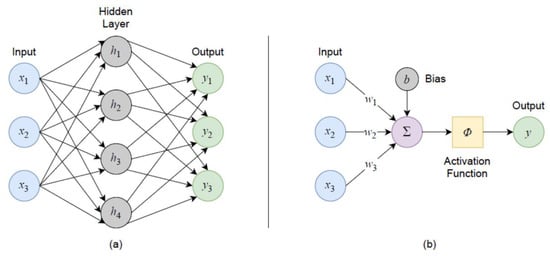
Figure 16.
The scheme of a feed-forward ANN: (a) architecture of the model; (b) neuron structure (taken from Ref. [65]).
Neural network training is also useful for timely detection of mining equipment breakdowns, damage to conveyor belts and other critically important large nodes, which can be achieved using convolutional neural network deep learning, as well as the integration of MobileNet and Yolov4 networks. Thus, the lightweight neural network showed the ability to detect damage of a conveyor belt at the initial stage of their formation with an accuracy of up to 93.22%, which can be considered as a fairly reliable result [66]. Drill bit failure prediction was made by using a one-dimensional convolutional neural network within deep learning. It provides 88.7% accuracy for the prediction of failures for all modes of horizontal drilling of a granite sample, including normal, high pressure and deviation and defective ones, as well as abrasion (Figure 17).
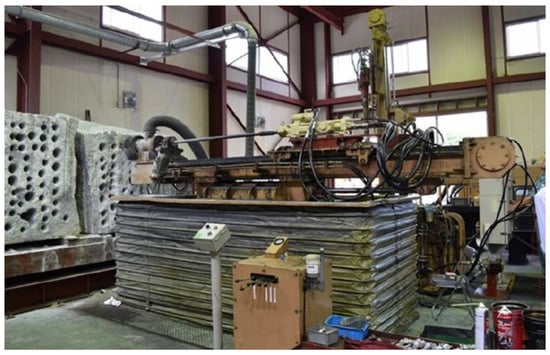
Figure 17.
Experimental 18 m3 of granite rock cube horizontally drilled with accelerometers; the data were transmitted to the logger and analyzed by one-dimensional convolutional neural network (taken from Ref. [67]).
To address higher-order problems such as pollution in mineral resource clusters, a “network without a teacher”—self-learning network—such as Kohonen’s network has proven itself well. It was observed when comparing actual success in reducing environmental pollution by enterprises in the extractive sector with the environmental strategies of the European Union, such as “The European Green Deal” (climate strategy) and the development of adjustments [68].
The analytical and predictive capabilities of neural networks are in demand for a special role in improving labor safety in coal mines, in particular their critical factor—preventing explosions of the methane–air mixture in underground workings. An excellent result in solving this problem at the level of predicting the concentration of methane is given by the synchronous processing of a large amount of current and historical data distributed over various faces in underground mine workings. The use of such deep learning networks as gated recurrent unit, recurrent neural network and long short-term memory for this purpose made it possible to support the methane concentration in the mine’s air of less than 1% [69].
Another critical aspect of fossil fuel extraction safety, which requires the use of neural networks, is related to reducing the risks of seismic events in areas of intensive mining, in particular coal, as well as unexpected water inflows and rock bursts. The use of wavelet scattering decomposition ANN and support vector machine in an artificial intelligence recognition model for the purposes of monitoring and early recognition of dynamic phenomena within the boundaries of intensively developed coal deposits provides high accuracy in predicting micro-seismic events [70]. The BP neural network model has proven itself to be a good risk assessment of rock bursts in the analysis of mechanical and drilling and blasting impact on coal seams during their underground mining (Figure 18).
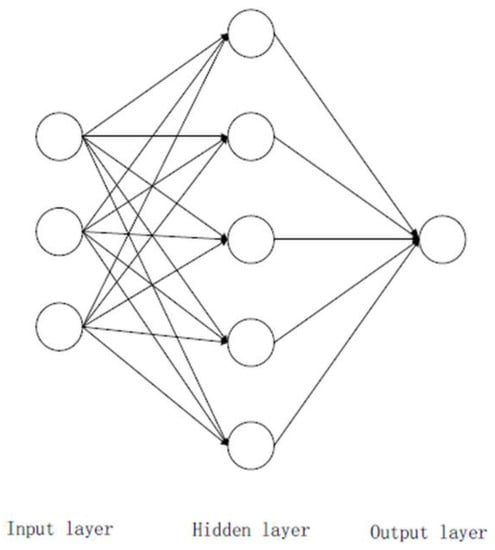
Figure 18.
Structure diagram of BP neural network (taken from Ref. [71]).
The neural network takes into account geological factors, using the adopted mining method and equipment, the depth of occurrence and dip angles. In general, the creation of interactive digital 3D models of seismic phenomena in clusters of intensive coal mining will allow for optimizing the parameters of the mining method and selecting equipment for predicting dynamic processes in the subsoil, which should be facilitated by training a neural network for forecasting based on semi-synthetic data (actual and calculated) [72].
Similarly, optimizing drilling and blasting parameters using an artificial neural network can channel a greater share of energy to the destruction of an array of mining operations (today up to 70% is lost), providing not only more efficient destruction but also reducing the seismic impact and the explosive release of combustion products [73].
Another sample of using neural links for the gradual transition to unmanned mining equipment, controlled by artificial intelligence, is a semi-robotic dump truck. The intermediate stage of such a transition is distancing of a human from direct control over the truck and interference only in dangerous and difficult situations. In Figure 19, the real dump truck BelAZ-7513R (Belarus) is shown, equipped with a GPS module, Delphi ESR radars (Delphi Technologies, Pittsburg, PA, USA) and Orlaco EMOS cameras (Orlaco Products. B.V., Barneveld, The Netherlands). The information from these sensors is processed by neural link; if the operator is forced to take manual control over the truck, 11 on-board cameras are used.
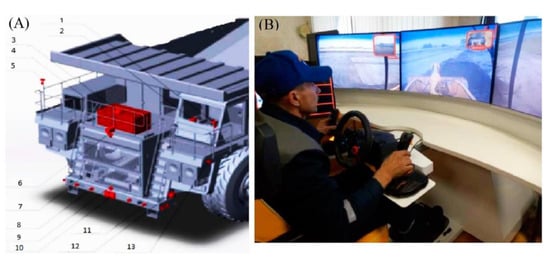
Figure 19.
(A) The main elements of an autonomous control system of the dump truck’s movement (BELAZ7513R): (1) GPS receiver; (2) information panel; (3) power box monitoring unit; (4) power box; (5) GPS receiver; (6) camera; (7) motion sensor (8) parctronic; (9) radar; (10) LiDAR; (11) parctronic; (12) camera; (13) round-view camera. (B) Remote driver workplace (taken from Ref. [74]).
Thus, the impact of neural networks on fossil fuels extraction is to transfer the process of making engineering, managerial, environmental, marketing and financial decisions from humans to artificial intelligence, without which it is impossible to stabilize energy markets in the future in the face of growing demand and fluctuations in the supply of renewable energy. In addition, neural links as a part of artificial intelligence are key to mining and energy equipment being fully autonomous.
3.9. Machine Vision
Machine vision, as the core technology of Mining 4.0, opens up new ways of smart (unmanned) mining robotization and allows for the introduction of collaborative robots—the core of the Mining 5.0 platform [75]. Automatic collection and analysis of various data—the basis of machine vision (Industry 4.0 technologies)—allow moving to Mining 5.0, in which human centricity is determined, among other things, by machine knowledge and independent decision making by machines, taking into account the imperative of ensuring labor safety and energy saving [76]. Optimism regarding the change in Mining 4.0 with Mining 5.0 is based on the transmitting of individual functions from human operators and mechanics to robots, with the subsequent replacement of people by collaborative robots [77].
Machine vision is called upon to improve the quality of fossil fuels, which is directly related to the emissions of greenhouse gases and other pollutants from thermal power plants. In particular, the neural network built into the host rock recognition PCViT module in the enriched coal is able to analyze hyperspectral data, automatically detecting impurities [78]. Along with the recognition of minerals, machine vision systems built on the convolutional neural network are able to analyze the state of the surface of a rock array. In particular, they are able to identify cracks in it with a high degree of certainty and predict various disturbances (shifts, landslides, subsidence, etc.) with an accuracy of up to 86%, which is illustrated in Figure 20.
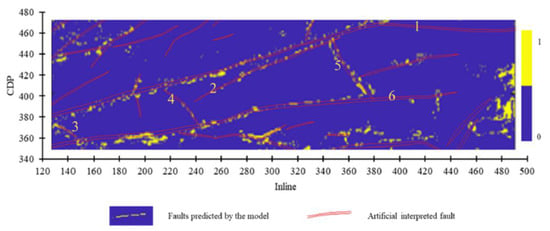
Figure 20.
The result of recognition of faults (from 1 to 6) in a training rock array by machine vision system (taken from Ref. [79]).
Figure 20 shows a successful rendering of the complete contours of cracks in the rock array, fragmentarily “read” using machine vision and reflected in the form of a graphic image (yellow segments) by a neural network (red lines). The neural network, taking into account the various physical and technical properties of rocks, draws the contours of a cracks with high accuracy (including the invisible part of the array, covered by sediments, etc.), increasing the reliability of predictions of landslides and collapses in the clusters of extensive mining.
Machine vision and learning make the bridge to Mining 5.0 and generate a spillover effect that occurs in related industries. They are associated, for example, with the use of artificial intelligence to predict the damage to surface constructions and buildings caused by harmful emissions into the air made by thermal power plants and coal mines. The application of naive Bayes classification and Bayesian belief networks, support vector machine, and a probabilistic neural network gives an accurate analysis of building damage using the TAN-CL AIC structure learning method [80].
Thus, the significance of machine vision for fossil fuels extraction is determined by the very possibility of increasing the productivity of mining equipment and achieving complete extraction of raw materials by combining other technologies of Mining 4.0’s core—the Internet of Things, neural networks, cloud computing, etc., into a single digital system of Computer Integrated Mining.
4. Place of Mining 4.0 and 5.0 in the Expected Expansion of Industry 5.0
The important role of Industry 5.0 in the process of integration of the mineral extraction sector into sustainable development lies in the shift in emphasis from the value of extracted fossil fuels for individual shareholders to the value for all stakeholders, due to the emergence of new business models based on artificial intelligence and machine learning [81].
Fossil energy resources mining and thermal power production in the diffusion of Industry 5.0 technologies inherit the platforms of innovative technologies of Mining 4.0 and Energy 4.0, which have been developing since the 2010s.
The transition to renewable energy sources (wind farms, photovoltaic parks, geothermal heating systems, hydropower plants) and innovations in battery systems for storing large amounts of excess energy should develop in parallel with greening, intelligent automation and simulation processes of fossil energy sources extraction and burning. This is necessary for achieving the global goal of NetZero 2050, subject to a smooth transition to an alternative power supply and a “seamless” connection of centralized and distributed power sources in a hybrid system [82]. Intelligent interconnection organized using Industry 5.0 (Energy 5.0) technologies will allow maintaining the reliability and profitability of energy networks by optimizing the consumption of traditional energy sources, giving priority to the development of renewable ones. In upcoming decades, the aim is to move toward stronger human societies and preservation of the Earth [83].
Producers of fossil fuels and non-renewable energy are a priori forced to learn from the transition to “smart social factories” such as Repsol’s smart control project based on Industry 4.0 technologies such as the blockchain, smart robotics to increase productivity and security and robots and automated vehicles [84]. At the same time, business processes become dynamically modified by taking into account market fluctuations and shocks, and changing their structure becomes a function of automatic real-time decisions performed in the blockchain network [85]. It is important for Southeast Asian countries, where a leap in economic development based on the production of digital goods of Industry 4.0’s level goes hand in hand with an increase in the use of energy from the “pre-oil” and “oil era”—Energy 2.0 and 3.0 [86].
In general, the “smart” organization of business processes and production chains in the field of extraction and burning of fossil fuels (Mining and Energy 4.0), taking into account the human centricity of Mining and Energy 5.0, is based on the main technological platform of Industry 5.0—integrated machine–human intelligence and neural network tools for strategic goal setting and planning (Figure 21).
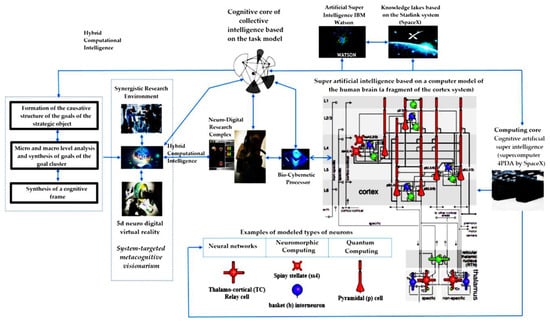
Figure 21.
Neuro-digital tools for strategic goal setting and planning for Industry 5.0, based on integrated machine–human intelligence (taken from Ref. [87]).
In addition, the expectations for the initiation of Mining 5.0 are associated with the introduction of convergent technologies—biochemical extraction of mineral raw materials without mechanical impact on the subsoil. The success of the use of RNA-modified chemolithotrophic acidophile bacteria for pyrite bio-oxidation should be noted [88].
5. Technological Platform for the Transition from Mining and Energy 4.0 to 5.0
A path of “seamless” transition to the fifth generation of fossil energy sources mining and power production is being formed today. It is associated with the end-to-end technology of the Internet of Energy and cyber-physical energy-saving systems. The continued growth of fossil energy production and burning for energy generation goes against the imperative of climate change and pollution mitigation in many ways. Therefore, the artificial intelligence and Internet interaction of energy machines and equipment should ensure the implementation of three directions for the transition to Mining and Energy 5.0: energy disaggregation; smart monitoring of supply voltage instability; smart management of production and networks [89].
The Internet of Energy ensures the optimization of the production, distribution, accumulation and consumption of all devices connected to the network (from power plants to electric machines) with each other, in accordance with the adaptation of the energy market’s rules to the goals and objectives of humanization and sustainable development of industrial production [27]. Artificial intelligence, machine learning and the Internet of Energy are in demand here at the stage of energy generation (to avoid unplanned downtime and critical breakdowns of generating equipment) and its transmission, distribution and consumption (smart meters for end-user control, smart microgrids and surplus trade management) [90]. The development of the Internet of Energy to the level of Energy 5.0 will make it possible to include energy systems based on fossil and renewable energy sources in a digital network to make its monitoring intelligent and increase the efficiency of energy consumption [9]. In turn, cyber-physical systems in mining and energy production lead to the fact that a possible excess of energy in the future will in itself affect the transition to Industry 5.0 on a global scale. This will make inevitable the symbiosis of renewable and non-renewable energy as an area of application of Energy 5.0 technologies, which cannot develop without Mining 5.0 [91].
The criterion for the effectiveness of the transition from Mining 3.0 to 4.0 in the production of fossil energy sources is saving up to 20% of all produced energy sources, and to Mining 5.0—an additional 22%. In turn, from the transition to Energy 4.0 with the characteristic expansion of artificial intelligence and the Internet of Things, savings of up to 12% of all consumed energy are expected, while the transition to Energy 5.0 can save another 20% during the implementation of cyber-physical systems [92]. Optimization of energy consumption is also possible by creating a digital twin for each fossil fuel power plant that is used for load planning and creating an intelligent response using advanced real-time Big Data analytics [93].
Using the technology of Industry 4.0’s “core”—neural networks—in the development of the Energy 4.0 platform to the level of 5.0 will solve the main problem of integrating renewable and non-renewable thermal energy (the development of which is directly related to Mining 4.0, and in the future, to 5.0)—the instability of wind and solar generation [9]. In particular, the use of advanced neural networks in machine learning methods (AutoML [94]) makes it possible to maintain the performance of thermal generation and, accordingly, to flexibly manage the extraction of fossil fuels for securing various modes of production of renewable energy (solar, wind and tidal generation), creating new incentives for the development of Mining 4.0 [95]. Equally important for the integration of distributed renewable and point non-renewable energy and the use of neural networks is the intelligent detection and identification of faults in power system nodes and monitoring the quality of electricity supplies (Figure 22).
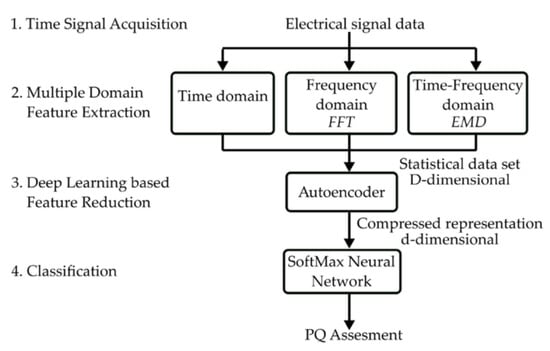
Figure 22.
Flowchart of the proposed deep-learning-based methodology applied to Power Quality Disturbance monitoring (taken from Ref. [96]).
The number of core technologies of Energy and Mining 4.0 can be reduced from the nine elements of Industry 4.0 (smart robots, system integration, Internet of Things, Big Data, CPS, interactive virtual modeling, cloud computing, augmented reality and additive manufacturing) to a smaller number. An illustrative example of such a reduction in the wood industry is shown in Figure 23.

Figure 23.
Reducing the focus on Industry 4.0 technologies based on their impact on energy efficiency (taken from Ref. [97]).
The increase in energy efficiency of extracting fossil fuels depends on the diffusion of digital technologies in mining and power industries. It should assist in solving the problems of instability and grid imbalance caused by the introduction of intermittent renewable energy generation. Along with the optimization of the extraction and supply of fossil fuels, achievable within the framework of Mining 4.0, Energy 4.0 digital technologies allow for relying on renewable generation, energy storage and flexible loads. The expected reduction in global CO2 emissions is projected at 4–6% [98]. Further, obtaining accurate information on energy losses and the performance of energy equipment motivate the joint development of traditional and renewable energy in order to create a common value for these sectors to reduce the carbon footprint and reduce production costs in the extraction and combustion of fossil energy through their digitalization [99].
In turn, smart grids will ensure the decentralization of energy production, which will allow consumers to manage the generation of solar and wind energy and control their consumption. At the same time, it should not be forgotten that by 2020 more than 60% of the world’s energy had come from fossil fuels, so the digitalization of its production processes is no less important than the production of green energy [100]. It is expected that the expansion of Energy 4.0 and Mining 4.0 will create a national and, in the future, a global energy system with a high degree of interconnectedness of traditional thermal and alternative green energy suppliers. Such a system will expand the possibilities of local energy markets [101], as well as create unprecedented opportunities for improving labor safety and the reliability of energy systems [102], in particular nuclear energy and a new direction of thermal energy: “burning plasma” [15].
In general, the sustainability of both fossil energy sources extraction and energy production is closely related to Industry 4.0, in which energy sustainability is presented as a function of the technological saturation of those business models that are formed under the influence of digital technologies in mining and energy sectors (Figure 24).
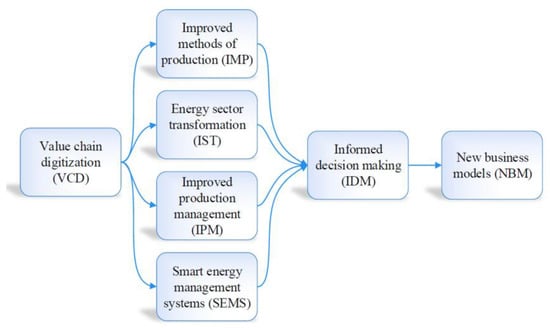
Figure 24.
The ISM-based model of energy sustainability functions of Industry 4.0 (taken from Ref. [103]).
It is important to note that Industry 4.0 technologies themselves create technological shocks, both for mining and energy; the problem of the safe development of artificial intelligence is especially acute today.
Safe and energy-efficient artificial intelligence should be developed, first of all, in the areas of integrating renewable and non-renewable energy sources, balancing the costs of producing equipment for green energy and related emissions into the environment, introducing energy-autonomous sensor systems in unknown environments and the simultaneous wireless transmission of information and energy [16].
6. Human-Oriented Core of Mining 5.0
The movement towards sustainable energy is marked by the need to meet its growing demand without compromising access to energy for future generations, while reducing the negative impact on the environment [104]. The transition to Mining 5.0 will, on one hand, guarantee a stable supply in the energy market in the face of fluctuations inherent in renewable energy, due to the high-performance extraction of fossil energy sources. On the other hand, Mining 5.0 technologies will ensure that the global energy demand is met in the event of an increase in future energy demand beyond the forecast, exceeding the possibilities of renewable energy.
Industry 4.0 has provided an important digital Mining 4.0 technology—5G (and prospective 6G) connection—the use of which in underground mines will allow the precise positioning of workers in the longwall and real-time monitoring of equipment, thanks to very low latency and high density of connection [105]. This will bring labor safety to a new level, corresponding to the human-centric concept of Industry 5.0.
Industry 5.0 provides an opportunity for a closed-loop transition in mining, which will significantly increase fossil fuel savings and reduce greenhouse gases. Mining 5.0 is inextricably linked to the use of Big Data analysis and neural networks in the design of such complex innovative industrial technologies as the full extraction of deep and depleted deposits, underground gasification and coal chemical dissolution. Along with the recycling of resources in the mining industry, Mining 5.0 is associated with post-mining (restoration of the environment, economic and social activity in spent mineral resource clusters) by using such technologies as machine vision, neural networks and cloud computing for the analysis of data coming from drones and inspector robots. In addition, a deep analysis of Big Data will accelerate the transition to green mining by balancing the demand and supply for fossil fuels and energy [106].
The radical difference between Mining 5.0 technologies and the previous platforms is associated with its human-oriented core—connecting a person and a machine with digital technologies instead of automating individual processes, supplementing human intelligence with machine intelligence (Table 2).

Table 2.
The steps and elements of Industry 1.0–5.0 diffusion in the mining sector (taken from Ref. [107]).
Mining 5.0, in fact, should answer the question of what Industry 5.0 technologies can do for people—investors, employees, managers of mining companies and consumers of traditional energy. This is more important than what people can do with technology (a self-generated innovation process). In other words, the high performance of robots has a limitation in the form of non-creative functioning—a result of the critical thinking that humans possess. Therefore, when interacting with people, smart robots will be able to go beyond the boundaries of efficiency characteristic of Industry 4.0 [108] (Figure 25).
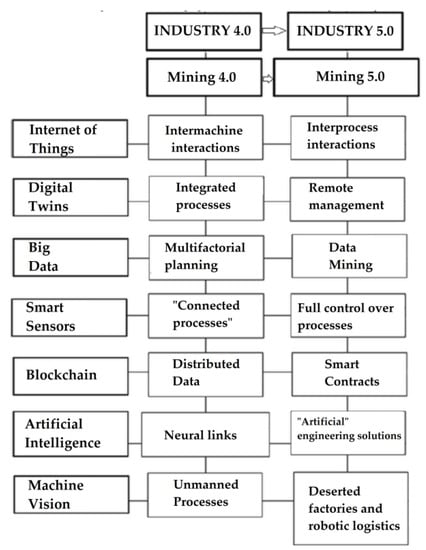
Figure 25.
Evolution of innovative technologies of Industry 5.0 (taken from Ref. [109]).
The human centricity of Mining 5.0 has an important environmental aspect—a radical reduction in the impact of fossil fuel extraction and burning on the environment in the course of the circular economy’s development, energy consumption optimization (the main task of Energy 4.0 and 5.0), greenhouse gas emissions and solid waste. No less important for human-centric mining is an unprecedented level of protection of economy from man-made accidents, natural disasters and cybersecurity threats and support of critical infrastructure during economic crises, which is a part of the spectrum of Mining 5.0 development tasks [81,110].
The European experience in the development of the Mining 5.0 platform contains post-mining as the most significant human-centered area of innovative development of the mining sector. For example, project TRIM4Post-Mining, funded by H2020/RFCS, aimed at the development of land restoration in several scenarios integrating real-time data into a single digital model using Big Data analytics. Then, a model of the post-mining information system (Transition Information Modeling System, TRIM) was created using virtual and augmented reality [111].
Fossil fuels in Mining 5.0 are connected with greenhouse gases emissions; at the same time, they are involved in the production of green fuels (such as hydrogen). For this, coal gasification and natural gas reformation and partial oxidation of oil and bitumen are used [112]. These are much less energy-intensive methods than the separation of water into its constituent hydrogen and oxygen [113]. The widespread application of hydrogen in chemical industry, along with burning as an energy carrier, determines the long-term growth in demand for it (Figure 26).

Figure 26.
Global annual demand for hydrogen (taken from Ref. [114]).
The growth in demand for fossil-derived green fuels is the quintessence of the convergent biochemical technologies, paving the way toward Industry and Mining 5.0. This is fully confirmed by the growth of investments in green technologies on a global scale (Figure 27).
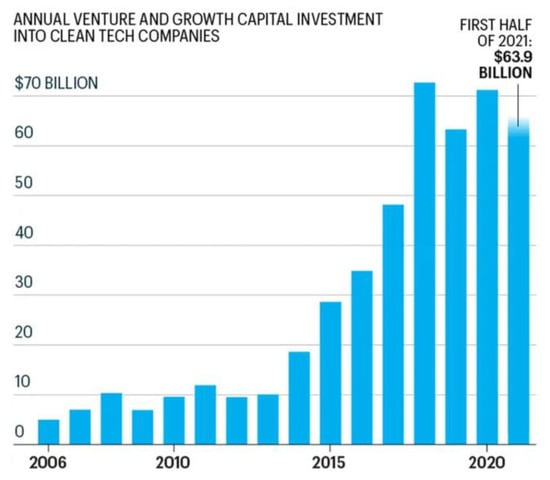
Figure 27.
The rise of cleantech investment (taken from Ref. [115]).
Cloud Mining is a technology that integrates a number of Mining 4.0 core technologies. It is the most advanced and consistent with the spirit of Mining 5.0, as it combines engineering, financial and logistics solutions through cloud resources and services. Managing the technological and business processes of mining without human intervention becomes possible at the level of entire clusters, rather than individual enterprises. It is based on the deep digitalization of five areas: relying only on digital data in the design and management of work, the use of only digital technologies in management, maximum development of employees’ digital competencies and a cloud form of interaction with business partners and counterparties (Figure 28).
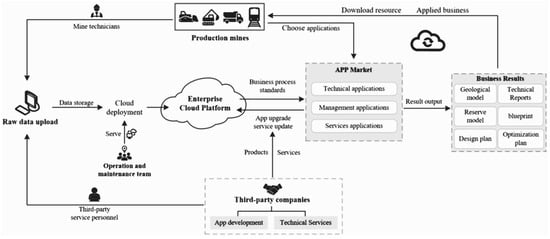
Figure 28.
Cloud Mining system (taken from Ref. [116]).
In the Cloud Mining system, the accessibility of data from different nodes of the industrial Internet of Things plays a key role, which is associated with the need to use special KPIs (key performance indicators) to assess the digital competencies of mining engineers necessary to form chains of cause-and-effect relationships in Mining 4.0. These relationships imply a coordinated optimization of financial, logistical and production business processes in the extraction of fossil fuels [117].
The limitations of the effectiveness of Mining 5.0 technologies’ implementation and the potential problems associated with them are primarily associated with the relatively low technological maturity of the extraction of fossil resources (Digital 2.0 [118]), which is lesser for metallurgy, chemical and woodworking industries (Digital 3.0 and 4.0, respectively). Another limitation of Mining 5.0’s future expansion is associated with the growing backlog of the mineral resource sector in investment attractiveness from high-tech industries, taking into account the upcoming full-scale change in generations of mining equipment [119]. Finally, we should not forget about the inertia of managers and workers’ thinking at mining enterprises, who see a threat to employment in the complete replacement of a person by a machine, as well as a generally wary attitude towards artificial intelligence among many decision and opinion makers.
Overcoming these limitations, we associate with the development of research in the field of full integration of fossil and renewable energy sources in the following areas:
- -
- Expansion of artificial intelligence and smart robots that is safe for humans;
- -
- Creation of flexible intelligent systems for planning investment and extraction of fossil fuels, integrated into the world energy market;
- -
- Designing new energy systems of cities and industrial clusters, taking into account the potential of both renewable and non-renewable energy.
7. Conclusions and Prospects
Fossil fuels mining is aimed at ensuring the stability of the power market and the energy availability for all countries. In scientific literature, it is associated with Industry 4.0, which forms the platform of Mining 4.0’s core technologies. The elements of such a platform are the Internet of Things, neural networks and artificial intelligence, Big Data and interactive 3D modeling. All these technologies allow for designing and managing processes in the extraction of fossil fuels without human intervention. However, the human-centric platform of Industry 5.0 requires a large-scale study of the role of fossil energy extraction (Mining 5.0) in achieving the goals of deficit-free energy consumption on the one hand and moving towards sustainable development on the other.
This review reflects on the results of studies that form a detailed picture of Mining 4.0 development and its future conversion to Mining 5.0 after the 2050s. These technological platforms should ensure the optimal participation of fossil energy sources in the expansion of Energy 4.0 and 5.0 platforms, which are expected to fully satisfy all the energy needs of mankind, along with achieving significant progress in sustainable development. In the works of many authors (scientific and review articles, conference papers and monographs) it is noted that Mining 4.0 technologies give rise to new elements of surface and underground geotechnology associated with ultra-precise interactive digital modeling, unmanned production and operational management of business processes, the highest labor safety and environment restoration.
The key findings of this review lie in the area of summarizing the positive experience of applying Industry 4.0 technologies in mining and analyzing the search for promising areas for the future development of Mining 5.0 in the face of fossil energy sources’ market fluctuations and rising power demand. These key findings include the following:
- -
- Defining the role of Industry 4.0 digital technologies in upgrading mining to a level that meets the needs of its stakeholders in cost-effective production and safe labor and the entire society in cheap, uninterrupted and clean energy;
- -
- Summing up the possibilities of Industry 5.0, which will make fossil fuels extraction and burning an important factor of sustainable energy in the future, when environmental requirements for industry, including in developing countries, will increase radically;
- -
- Defining the basis for the integration of Mining 4.0 and Energy 4.0 technologies within the framework of the future sustainable Energy 5.0. Its supporting elements are the following: intelligent forecasting and planning along the entire energy production chain in the balance of its renewable and non-renewable components; development of intelligent control of power consumption in the mining sector; transition to the production of green fuels (such as hydrogen) from fossil hydrocarbons; implementation of convergent digital post-mining technologies.
Deep digitalization of minerals extraction provides productivity growth in the fossil energy sector, sufficient for sustainable energy development in the transition to Energy 4.0—a platform in which the Internet of Energy, artificial intelligence and neural networks are dominating, allowing the balance of energy production to shift from renewable and non-renewable sources. Hence, the domain structure of Mining 4.0, highlighted by most of the authors of the analyzed works, includes cloud mining, industrial Internet of Things, machine vision and learning, cyber-physical systems, 3D visualization and augmented reality, Computational Fluid Dynamics, blockchain and digital twins, smart robots and drones (the basis of unmanned prey).
In the near future, Mining 5.0 will be subject to the same imperatives as Energy 5.0—human centricity and all-round preservation of the environment. From the extraction of fossil energy sources, full extraction of mineral raw materials is expected here, its burning having minimal impact on the environment, and the achievement of a labor safety level that meets the expectations of a post-industrial society.
In accordance with this, Mining 5.0’s technological platform includes a new generation of neural networks (deep learning), connecting unmanned mining enterprises with smart energy networks to extract and burn fossil energy sources in the volumes required to compensate for renewable energy failures (the Duck Curve).
However, the special role of Mining 5.0 is played by its human-centric nature. In connection with that, its technological platform includes advanced cybersecurity and cloud mining technologies, collaborative robots in mines, recycling of mineral raw materials and its complete extraction using neural networks for Big Data analysis, total post-mining and use of fossil hydrocarbons for the production of green hydrogen fuel.
In turn, the barriers of Mining 4.0 development, which must be overcome in order to create a “platform” for movement to Mining 5.0, are connected with objective and subjective problems of mining production processes transformation (as well as the production and distribution of energy) under the control of smart robots and artificial intelligence. Objective obstacles are associated with the limited ability of cyber-physical systems to operate effectively in the face of unpredictable man-made disasters, fluctuations of prices in the energy market, the rise of cybersecurity risks and acceleration of scientific and technological progress. The subjective barriers of Mining 4.0 development are associated with the fear of handing full control of technological and business processes from people to machines, as well as with a rather narrow understanding of the goals and objectives of Mining 4.0 as an integral part of sustainable development.
The performed analysis of works in the field of Mining 5.0 made it possible to single out the integration of Industry 4.0 technologies as the mainstream of diffusion of Industry 5.0 technologies in the resource sector. In particular, the integration of such core elements of Industry 4.0 as Internet of Things, digital twins, blockchain, neural links into Computer Integrated Mining, cloud mining and digital intelligent control of production chains from full fossil fuels mining to power production and distribution systems is expected in upcoming decades.
Based on the key findings of this review, the following recommendations were offered:
- (A)
- Intensification of research activity in the field of integration of digital technologies of renewable and non-renewable energy and uniform and fair satisfaction of the energy needs in all countries, taking into account the availability of hydrocarbons;
- (B)
- Focusing the attention of researchers on the potential of digital technologies of Mining 4.0, and in the future Mining 5.0, in the field of achieving the Sustainable Development Goals related to affordable energy and land and water conservation;
- (C)
- Supplementing existing national energy strategies and charters with provisions on harmonizing the technological development of energy production from renewable and fossil sources and fixing Mining 4.0 and 5.0 technologies as a priority for energy security.
We see the answers to the challenges in accelerating the transition to Mining 5.0—a more information-protected and human-centric platform for mining sector development, in which machines will not replace but cooperate with people. From the transition to Mining 5.0, we expect a radical increase in productivity and labor safety, along with the exit of the mining sector from the most significant sources of environmental pollution.
Author Contributions
Supervision, methodology and investigation, S.Z.; conceptualization, formal analysis and writing—review and editing, E.D. All authors have read and agreed to the published version of the manuscript.
Funding
This research received no external funding.
Data Availability Statement
Not applicable.
Conflicts of Interest
The authors declare no conflict of interest.
References
- Wickens, C.D.; Hollands, J.G.; Banbury, S.; Parasuraman, R. Engineering Psychology & Human Performance; Psychology Press: Hove, UK, 2015. [Google Scholar]
- Stefanini Group. What Is Industry 5.0? How Shifting Objectives Enables Transformation. 4 November 2022. Available online: https://stefanini.com/en/insights/news/what-is-industry-50-how-shifting-objectives-enables-transformation (accessed on 10 July 2023).
- Cehlar, M. The structural role of convergent technologies in the modern economy. Econ. Innov. Manag. 2019, 3, 24–31. [Google Scholar] [CrossRef]
- Mikhailov, V.G.; Zhironkin, V.S. Development of recycling economy technologies in the context of transition to Industry 4.0. Econ. Innov. Manag. 2022, 4, 57–69. [Google Scholar] [CrossRef]
- Hu, T. Technological core and economic aspects of modernization on the Industry 4.0 platform. Econ. Innov. Manag. 2022, 3, 5–18. [Google Scholar] [CrossRef]
- Hu, T. Review of national strategies for transition to industry 5.0. Econ. Innov. Manag. 2022, 3, 28–38. [Google Scholar] [CrossRef]
- Fataliyev, T.K.; Mehdiyev, S.A. The Impact of Industry 4.0 on the Formation of Science 4.0. Probl. Inf. Technol. 2022, 13, 40–47. [Google Scholar] [CrossRef]
- Breque, M.; De Nul, L.; Petridis, A. Industry 5.0: Towards a Sustainable, Human-Centric and Resilient European Industry; Publications Office of the European Union: Luxembourg, 2021. Available online: https://data.europa.eu/doi/10.2777/308407 (accessed on 10 July 2023).
- Singh, R.; Akram, S.V.; Gehlot, A.; Buddhi, D.; Priyadarshi, N.; Twala, B. Energy System 4.0: Digitalization of the Energy Sector with Inclination towards Sustainability. Sensors 2022, 22, 6619. [Google Scholar] [CrossRef] [PubMed]
- Elangovan, U. Industry 5.0: The Future of the Industrial Economy; CRC Press: Boca Raton, FL, USA, 2021; 152p. [Google Scholar]
- Fu, C.; Zhang, H. Evaluation of Urban Ecological Livability from a Synergistic Perspective: A Case Study of Beijing City, China. Sustainability 2023, 15, 10476. [Google Scholar] [CrossRef]
- Maddikunta, P.K.R.; Pham, Q.-V.; Ba, P.; Deepa, N.; Dev, K. Industry 5.0: A Survey on Enabling Technologies and Potential Applications. J. Ind. Inf. Integr. 2021, 8, 257. [Google Scholar] [CrossRef]
- SAP. Industry 5.0: Adding the Human Edge to Industry 4.0. Available online: https://www.sap.com/insights/industry-5-0.html (accessed on 10 July 2023).
- Zhdaneev, O.; Chuboksarov, V. Prospects for Industry 4.0 Technologies in the Fuel and Energy Complex of Russia. Energy Policy 2020, 7, 16–33. [Google Scholar] [CrossRef]
- Carayannis, E.G.; Draper, J.; Bhaneja, B. Towards Fusion Energy in the Industry 5.0 and Society 5.0 Context: Call for a Global Commission for Urgent Action on Fusion Energy. J. Knowl. Econ. 2021, 12, 1891–1904. [Google Scholar] [CrossRef]
- Zeb, S.; Mahmood, A.; Khowaja, S.A.; Dev, K.; Hassan, S.A.; Qureshi, F.N.M.; Gidlund, M.; Bellavista, P. Industry 5.0 is Coming: A Survey on Intelligent NextG Wireless Networks as Technological Enablers. arXiv 2022, 2205, 09084. [Google Scholar] [CrossRef]
- Zizic, M.C.; Mladineo, M.; Gjeldum, N.; Celent, L. From Industry 4.0 towards Industry 5.0: A Review and Analysis of Paradigm Shift for the People, Organization and Technology. Energies 2022, 15, 5221. [Google Scholar] [CrossRef]
- Abrahamsson, L.; Johansson, B.; Johansson, J. Future of metal mining: Sixteen predictions. Int. J. Min. Miner. Eng. 2009, 1, 304–312. [Google Scholar] [CrossRef]
- Carrasco, Y. Mining 4.0: A Digital Transformation Approach to Mining Sector. In Proceedings of the Conference “Technology Management and Leadership in Digital Transformation–Looking Ahead to Post-COVID Era”, Portland, OR, USA, 7–11 August 2022; pp. 1–6. [Google Scholar]
- Faz-Mendoza, A.; Gamboa-Rosales, N.K.; Medina-Rodriguez, C.E.; Casas-Valadez, M.A.; Castorena-Robles, A.; Lopez-Robles, J.R. Intelligent processes in the context of Mining 4.0: Trends; research challenges and opportunities. In Proceedings of the 2020 International Conference on Decision Aid Sciences and Application (DASA), Sakheer, Bahrain, 8–9 November 2021; IEEE: Piscataway, NJ, USA, 2021; p. 9317095. [Google Scholar] [CrossRef]
- Bertayeva, K.; Panaedova, G.; Natocheeva, N.; Kulagovskaya, T.; Belyanchikova, T. Industry 4.0 in the mining industry: Global trends and innovative development. E3S Web Conf. 2019, 135, 04026. [Google Scholar] [CrossRef]
- Carrasco, Y. Technology and Innovation Management in Open-Pit Peruvian Mining: Case Studies. In Proceedings of the 28th International Conference for Management of Technology (IAMOT 2019). National Institute of Industrial Engineering, Mumbai, India, 8–10 April 2019; pp. 136–141. [Google Scholar]
- Loow, J.; Abrahamsson, L.; Johansson, J. Mining 4.0–the Impact of New Technology from a Work Place Perspective. Min. Metall. Explor. 2019, 36, 701–707. [Google Scholar] [CrossRef]
- Smith, K.; Sepasgozar, S. Governance, Standards and Regulation: What Construction and Mining Need to Commit to Industry 4.0. Buildings 2022, 12, 1064. [Google Scholar] [CrossRef]
- Baek, J.; Choi, Y. A New GIS-Based Algorithm to Support Initial Transmitter Layout Design in Open-Pit Mines. Energies 2018, 11, 3063. [Google Scholar] [CrossRef]
- Hossein, M.N.; Mohammadrezaei, M.; Hunt, J.; Zakeri, B. Internet of Things (IoT) and the Energy Sector. Energies 2020, 13, 494. [Google Scholar] [CrossRef]
- Joseph, A.; Balachandra, P. Energy Internet, the Future Electricity System: Overview, Concept, Model Structure and Mechanism. Energies 2020, 13, 4242. [Google Scholar] [CrossRef]
- Park, S.; Jung, D.; Nguyen, H.; Choi, Y. Diagnosis of Problems in Truck Ore Transport Operations in Underground Mines Using Various Machine Learning Models and Data Collected by Internet of Things Systems. Minerals 2021, 11, 1128. [Google Scholar] [CrossRef]
- The Challenge of Industry 4.0 and the Demand for New Answers; IndustriALL Head Office: Geneva, Switzerland, 2020; 36p.
- BPM InfoSys. IoT in Mining. Available online: https://www.infosysbpm.com/blogs/sourcing-procurement/iot-in-mining.html (accessed on 10 July 2023).
- Vitor, R.F. Enabling Digital Twins in Industry 4.0. Lect. Notes Bus. Inf. Process. 2022, 455, 7–24. [Google Scholar] [CrossRef]
- Cogswell, D.; Paramatmuni, C.; Scotti, L.; Moffat, J. Guidance for Materials 4.0 to interact with a digital twin. Data-Centric Eng. 2022, 3, e21. [Google Scholar] [CrossRef]
- SAP SE. The Intelligent Enterprise for the Mining Industry Making Mining More Agile and Sustainable from the Pit to the Customer. August 2022. Available online: https://www.sap.com/documents/2017/11/3eb0f65b-dd7c-0010-82c7-eda71af511fa.html (accessed on 10 July 2023).
- Build a Digital Twin with Process Mining. Use Digital Twin Models to Improve Your Decision-Making. Available online: https://apromore.com/build-a-digital-twin-model-with-process-mining/ (accessed on 10 July 2023).
- Huang, A.; Huo, Y.; Yang, J.; Gu, H.; Li, G. Computational Modeling and Prediction on Viscosity of Slags by Big Data Mining. Minerals 2020, 10, 257. [Google Scholar] [CrossRef]
- Tyleckova, E.; Noskievicova, D. The role of big data in Industry 4.0 in mining industry in Serbia. CzOTO 2020, 2, 166–173. [Google Scholar] [CrossRef]
- Duan, M.; Huang, Q.; Xu, R.; Wang, C.; Xu, J. Optimization of Shearer Drum Based on Multi-Objective Bat Algorithm with Grid (MOBA/G). Machines 2022, 10, 733. [Google Scholar] [CrossRef]
- Li, S.; Chen, J.; Liu, C. Overview on the Development of Intelligent Methods for Mineral Resource Prediction under the Background of Geological Big Data. Minerals 2022, 12, 616. [Google Scholar] [CrossRef]
- Liu, C.; Chen, J.; Li, S.; Qin, T. Construction of Conceptual Prospecting Model Based on Geological Big Data: A Case Study in Songtao-Huayuan Area, Hunan Province. Minerals 2022, 12, 669. [Google Scholar] [CrossRef]
- Stupar, D.I.; Ogrizovic, V.; Roser, J.; Vizintin, G. Analytical and Numerical Solution for Better Positioning in Mines with Potential Extending Application in Space Mining. Minerals 2022, 12, 640. [Google Scholar] [CrossRef]
- Ullo, S.L.; Sinha, G.R. Advances in Smart Environment Monitoring Systems Using IoT and Sensors. Sensors 2020, 20, 3113. [Google Scholar] [CrossRef]
- Jurdziak, L.P.; Błazej, R.; Bajda, M. Conveyor Belt 4.0. In Book: Intelligent Systems in Production Engineering and Maintenance; Kacprzyk, J., Ed.; Springer: New York, NY, USA, 2011. [Google Scholar] [CrossRef]
- Dabek, P.; Szrek, J.; Zimroz, R.; Wodecki, J. An Automatic Procedure for Overheated Idler Detection in Belt Conveyors Using Fusion of Infrared and RGB Images Acquired during UGV Robot Inspection. Energies 2022, 15, 601. [Google Scholar] [CrossRef]
- Liu, Y.; Liu, Z.; Gao, K.; Huang, Y.; Zhu, C. Efficient Graphical Algorithm of Sensor Distribution and Air Volume Reconstruction for a Smart Mine Ventilation Network. Sensors 2022, 22, 2096. [Google Scholar] [CrossRef] [PubMed]
- Zietek, B.; Banasiewicz, A.; Zimroz, R.; Szrek, J.; Gola, S. A Portable Environmental Data-Monitoring System for Air Hazard Evaluation in Deep Underground Mines. Energies 2020, 13, 6331. [Google Scholar] [CrossRef]
- Fan, H.; Gao, X.; Yang, J.; Deng, K.; Yu, Y. Monitoring Mining Subsidence Using A Combination of Phase-Stacking and Offset-Tracking Methods. Remote Sens. 2015, 7, 9166–9183. [Google Scholar] [CrossRef]
- Ilieva, M.; Polanin, P.; Borkowski, A.; Gruchlik, P.; Smolak, K.; Kowalski, A.; Rohm, W. Mining Deformation Life Cycle in the Light of InSAR and Deformation Models. Remote Sens. 2019, 11, 745. [Google Scholar] [CrossRef]
- Du, S.; Wang, Y.; Zheng, M.; Zhou, D.; Xia, Y. Goaf Locating Based on InSAR and Probability Integration Method. Remote Sens. 2019, 11, 812. [Google Scholar] [CrossRef]
- Du, S.; Mallorqui, J.J.; Fan, H.; Zheng, M. Improving PSI Processing of Mining Induced Large Deformations with External Models. Remote Sens. 2020, 12, 3145. [Google Scholar] [CrossRef]
- Gabrys, M.; Ortyl, L. Georeferencing of Multi-Channel GPR–Accuracy and Efficiency of Mapping of Underground Utility Networks. Remote Sens. 2020, 12, 2945. [Google Scholar] [CrossRef]
- Rozmus, M.; Tokarczyk, J.; Michalak, D.; Dudek, M.; Szewerda, K.; Rotkegel, M.; Lamot, A.; Roser, J. Application of 3D Scanning; Computer Simulations and Virtual Reality in the Redesigning Process of Selected Areas of Underground Transportation Routes in Coal Mining Industry. Energies 2021, 14, 2589. [Google Scholar] [CrossRef]
- Janus, J.; Ostrogorski, P. Underground Mine Tunnel Modelling Using Laser Scan Data in Relation to Manual Geometry Measurements. Energies 2022, 15, 2537. [Google Scholar] [CrossRef]
- Martelet, G.; Gloaguen, E.; Dossing, A.; Lima Simoes da Silva, E.; Linde, J.; Rasmussen, T.M. Airborne/UAV Multisensor Surveys Enhance the Geological Mapping and 3D Model of a Pseudo-Skarn Deposit in Ploumanach, French Brittany. Minerals 2021, 11, 1259. [Google Scholar] [CrossRef]
- Wang, J.; Zhao, H.; Bi, L.; Wang, L. Implicit 3D Modeling of Ore Body from Geological Boreholes Data Using Hermite Radial Basis Functions. Minerals 2018, 8, 443. [Google Scholar] [CrossRef]
- Čebašek, V.; Rupar, V.; Đenadić, S.; Miletić, F. Cutting Resistance Laboratory Testing Methodology for Underwater Coal Mining. Minerals 2021, 11, 564. [Google Scholar] [CrossRef]
- Lim, J.-H.; Kim, H.-W.; Hong, S.; Oh, J.-W.; Bae, D.-S. Simulation Technology Development for Dynamic Analysis of Mechanical System in Deep-Seabed Integrated Mining System Using Multibody Dynamics. Minerals 2022, 12, 498. [Google Scholar] [CrossRef]
- Dickey, J.P.; Eger, T.R.; Frayne, R.J.; Delgado, G.P.; Ji, X. Research Using Virtual Reality: Mobile Machinery Safety in the 21st Century. Minerals 2013, 3, 145–164. [Google Scholar] [CrossRef]
- Borowski, P.F. Digitization, Digital Twins, Blockchain, and Industry 4.0 as Elements of Management Process in Enterprises in the Energy Sector. Energies 2021, 14, 1885. [Google Scholar] [CrossRef]
- Wang, X.; Yao, F.; Wen, F. Applications of Blockchain Technology in Modern Power Systems: A Brief Survey. Energies 2022, 15, 4516. [Google Scholar] [CrossRef]
- Pincheira, M.; Antonini, M.; Vecchio, M. Integrating the IoT and Blockchain Technology for the Next Generation of Mining Inspection Systems. Sensors 2022, 22, 899. [Google Scholar] [CrossRef]
- Huang, Y.; Fan, J.; Yan, Z.; Li, S.; Wang, Y. A Gas Concentration Prediction Method Driven by a Spark Streaming Framework. Energies 2022, 15, 5335. [Google Scholar] [CrossRef]
- Crespo Marquez, A.; de la Fuente Carmona, A.; Antomarioni, S. A Process to Implement an Artificial Neural Network and Association Rules Techniques to Improve Asset Performance and Energy Efficiency. Energies 2019, 12, 3454. [Google Scholar] [CrossRef]
- Polo, F.A.O.; Bermejo, J.F.; Fernandez, J.F.G.; Marquez, A.C. Failure mode prediction and energy forecasting of PV plants to assist dynamic maintenance tasks by ANN based models. Renew. Energy 2015, 81, 227–238. [Google Scholar] [CrossRef]
- Joshi, D.; Paithanka, A.; Chatterjee, S.; Equeenuddin, S.M. Integrated Parametric Graph Closure and Branch-and-Cut Algorithm for Open Pit Mine Scheduling under Uncertainty. Mining 2022, 2, 32–51. [Google Scholar] [CrossRef]
- Wilson, R.; Mercier, P.H.J.; Navarra, A. Integrated Artificial Neural Network and Discrete Event Simulation Framework for Regional Development of Refractory Gold Systems. Mining 2022, 2, 123–154. [Google Scholar] [CrossRef]
- Zhang, M.; Zhang, Y.; Zhou, M.; Jiang, K.; Shi, H.; Yu, Y.; Hao, N. Application of Lightweight Convolutional Neural Network for Damage Detection of Conveyor Belt. Appl. Sci. 2021, 11, 7282. [Google Scholar] [CrossRef]
- Senjoba, L.; Sasaki, J.; Kosugi, Y.; Toriya, H.; Hisada, M.; Kawamura, Y. One-Dimensional Convolutional Neural Network for Drill Bit Failure Detection in Rotary Percussion Drilling. Mining 2021, 1, 297–314. [Google Scholar] [CrossRef]
- Brodny, J.; Tutak, M. The Use of Artificial Neural Networks to Analyze Greenhouse Gas and Air Pollutant Emissions from the Mining and Quarrying Sector in the European Union. Energies 2020, 13, 1925. [Google Scholar] [CrossRef]
- Meng, X.; Chang, H.; Wang, X. Methane Concentration Prediction Method Based on Deep Learning and Classical Time Series Analysis. Energies 2022, 15, 2262. [Google Scholar] [CrossRef]
- Fan, X.; Cheng, J.; Wang, Y.; Li, S.; Yan, B.; Zhang, Q. Automatic Events Recognition in Low SNR Microseismic Signals of Coal Mine Based on Wavelet Scattering Transform and SVM. Energies 2022, 15, 2326. [Google Scholar] [CrossRef]
- Zhang, K.; Zhu, J.; He, M.; Jiang, Y.; Zhu, C.; Li, D.; Kang, L.; Sun, J.; Chen, Z.; Wan, X. Research on Intelligent Comprehensive Evaluation of Coal Seam Impact Risk Based on BP Neural Network Model. Energies 2022, 15, 3292. [Google Scholar] [CrossRef]
- Elmoutti, M.; Hodgkinson, J.; Dean, P. Prediction of Mining Conditions in Geotechnically Complex Sites. Mining 2021, 1, 279–296. [Google Scholar] [CrossRef]
- Al-Bakr, A.Y.; Sazid, M. Application of Artificial Neural Network (ANN) for Prediction and Optimization of Blast-Induced Impacts. Mining 2021, 1, 315–334. [Google Scholar] [CrossRef]
- Dubinkin, D.; Sadovets, V.; Syrkin, I.; Chicherin, I. Assessment of the Need to Create Control Sytem of Unmanned Dump Truck. E3S Web Conf. 2020, 177, 03022. [Google Scholar] [CrossRef]
- Kumar, P.; Singh, D.; Bhamu, J. Machine Vision in Industry 4.0: Applications; Challenges and Future Directions. In Machine Vision for Industry 4.0. Applications and Case Studies; Raut, R., Krit, S., Chatterje, P., Eds.; CRC Press: Boca Raton, FL, USA, 2022; pp. 1–13. [Google Scholar] [CrossRef]
- Odeyar, P.; Apel, D.B.; Hall, R.; Zon, B.; Skrzypkowski, K. A Review of Reliability and Fault Analysis Methods for Heavy Equipment and Their Components Used in Mining. Energies 2022, 15, 6263. [Google Scholar] [CrossRef]
- Gackowiec, P.; Brzychczy, E.; Kesek, M. Enhancement of Machinery Activity Recognition in a Mining Environment with GPS Data. Energies 2021, 14, 3422. [Google Scholar] [CrossRef]
- Yang, J.; Chang, B.; Zhang, Y.; Luo, W. PCViT: A Pre-Convolutional ViT Coal Gangue Identification Method. Energies 2022, 15, 4189. [Google Scholar] [CrossRef]
- Zou, G.; Liu, H.; Ren, K.; Deng, B.; Xue, J. Automatic Recognition Based on Convolutional Neural Network. Energies 2022, 15, 3758. [Google Scholar] [CrossRef]
- Chomacki, L.; Rusek, J.; Słowik, L. Machine Learning Methods in Damage Prediction of Masonry Development Exposed to the Industrial Environment of Mines. Energies 2022, 15, 3958. [Google Scholar] [CrossRef]
- Mateo, F.W.; Redchuk, A.; Tornillo, J.E. Industry 5.0 and new business models in mining. Adoption Case of Machine Learning to optimize the process at a copper Semi Autogenous Grinding (SAG) Mill. In Proceedings of the 5th European International Conference on Industrial Engineering and Operations Management, Rome, Italy, 26–28 July 2022. [Google Scholar]
- International Energy Agency Report. Net Zero by 2050: A Roadmap for the Global Energy System. 2021. Available online: https://www.energy.gov/sites/default/files/2021-12/IEA%2C%20Net%20Zero%20by%202050.pdf (accessed on 10 July 2023).
- Tsotsos, H. Energy 5.0: How Digital Transformation in the Energy Sector will Affect Future Manufacturing, Environment and Societies. Industry 4.0. 10 August 2022. Available online: https://industry4o.com/2022/08/10/energy-5-0/ (accessed on 10 July 2023).
- Adel, A. Future of industry 5.0 in society: Human-centric solutions, challenges and prospective research areas. J. Cloud Comput. 2022, 11, 40. [Google Scholar] [CrossRef]
- Massaro, A. Advanced Control Systems in Industry 5.0 Enabling Process Mining. Sensors 2022, 22, 8677. [Google Scholar] [CrossRef]
- Li, Y. Industry 4.0 and Energy 4.0 for Southeast Asia. The Diplomat. 21 May 2015. Available online: https://thediplomat.com/2015/05/industry-4-0-and-energy-4-0-for-southeast-asia/ (accessed on 10 July 2023).
- Babkin, A.V.; Koryagin, S.I.; Liberman, I.V.; Klachek, P.M.; Bogdanova, A.A.; Saghatelyan, N.H. Industry 5.0: A Neuro-Digital Tool for Strategic Goal-Setting and Planning. Tech. Technol. Probl. Serv. 2022, 3, 64–85. Available online: https://sciup.org/industrija-50nejro-cifrovoj-instrumentarij-strategicheskogo-celepolaganija-i-148324959 (accessed on 10 July 2023).
- Jimenez-Paredes, A.E.; Alfaro-Saldana, E.F.; Hernandez-Sanchez, A.; Garcia-Meza, J.V. An Autochthonous Acidithiobacillus ferrooxidans Metapopulation Exploited for Two-Step Pyrite Biooxidation Improves Au/Ag Particle Release from Mining Waste. Mining 2021, 1, 335–350. [Google Scholar] [CrossRef]
- Kaselimi, M.; Protopapadakis, E.; Voulodimos, A.; Doulamis, N.; Doulamis, A. Towards Trustworthy Energy Disaggregation: A Review of Challenges, Methods, and Perspectives for Non-Intrusive Load Monitoring. Sensors 2022, 22, 5872. [Google Scholar] [CrossRef] [PubMed]
- Industry 4.0 Opportunities behind the Challenge. In Proceedings of the Background Paper of UNIDO General Conference 17 “Partnering for Impact” Achieving the SDGS, Vienna, Austria, 27 November–1 December 2017; Available online: https://sdg.iisd.org/news/unido-conference-focuses-on-partnerships-for-achieving-isid-gender-equality/ (accessed on 10 July 2023).
- Lang, M. From Industry 4.0 to Energy 4.0: Future Business Models and Legal Relations; Conference Report of Digitalisierung in der Energiewirtschaft XX; Jahrestagung Institut für Berg- und Energierecht: Bochum, Germany, 17 March 2016; Available online: http://wise.co.th/wise/References/Creative_Economy/From_Industry_4_to_Energy_4.pdf (accessed on 10 July 2023).
- Dwyer, B.; Bassa, J. Combining IoT, Industry 4.0, and Energy Management Suggests Exciting Future in Tech Logo. ISA’s Flagship Publications. March/April 2018. Available online: https://www.isa.org/intech-home/2018/march-april/features/combining-iot-industry-4-0-and-energy-management (accessed on 10 July 2023).
- Digital Transformation in Energy Industry–Energy 4.0. Powertech Review. 27 January 2020. Available online: https://powertechreview.com/digital-transformation-in-energy-industry-energy-4-0/ (accessed on 10 July 2023).
- He, X.; Zhao, K.; Chu, X. A survey of the state-of-the-art. Knowl. Based Syst. 2021, 2012, 106622. [Google Scholar] [CrossRef]
- Ashraf, W.M.; Uddin, G.M.; Farooq, M.; Riaz, F.; Ahmad, H.A.; Kamal, A.H.; Anwar, S.; El-Sherbeeny, A.M.; Khan, M.H.; Hafeez, N.; et al. Construction of Operational Data-Driven Power Curve of a Generator by Industry 4.0 Data Analytics. Energies 2021, 14, 1227. [Google Scholar] [CrossRef]
- Gonzalez-Abreu, A.-D.; Delgado-Prieto, M.; Osornio-Rios, R.-A.; Saucedo-Dorantes, J.-J.; Romero-Troncoso, R.-d.-J. A Novel Deep Learning-Based Diagnosis Method Applied to Power Quality Disturbances. Energies 2021, 14, 2839. [Google Scholar] [CrossRef]
- Haddouche, M.; Ilinca, A. Energy Efficiency and Industry 4.0 in Wood Industry: A Review and Comparison to Other Industries. Energies 2022, 15, 2384. [Google Scholar] [CrossRef]
- Teba, C. Energy 4.0: How Digital Evolution is Shaping the Future of Electricity. Energy Intelligence. 29 January 2021. Available online: https://www.dexma.com/blog-en/energy-4-0-how-digital-revolution-is-shaping-the-future-of-electricity/ (accessed on 10 July 2023).
- Nota, G.; Nota, F.D.; Peluso, D.; Toro Lazo, A. Energy Efficiency in Industry 4.0: The Case of Batch Production Processes. Sustainability 2020, 12, 6631. [Google Scholar] [CrossRef]
- Davis, B. How Industry 4.0 Can Impact Energy. Solar Magazine. 14 March 2023. Available online: https://solarmagazine.com/how-industry-4-0-can-impact-energy/ (accessed on 10 July 2023).
- Industry 4.0 in the energy sector. Biznes Alert. 24 July 2019. Available online: https://biznesalert.com/industry-4-0-in-the-energy-sector/ (accessed on 10 July 2023).
- Borowski, P.F. Innovative Processes in Managing an Enterprise from the Energy and Food Sector in the Era of Industry 4.0. Processes 2021, 9, 381. [Google Scholar] [CrossRef]
- Tan, C.; Ghobakhloo, M. Energy sustainability and industry 4.0. IOP Conf. Ser. Earth Environ. Sci. 2020, 463, 012090. [Google Scholar] [CrossRef]
- Konchalovic, D.; Nikolic, J.; Djokic, A.; Momcilovic, P.; Zivkovic, D. Energy Cooperatives and a Just Transition in Southeast Europe. Energy Sustain. Soc. 2023, 13, 21. [Google Scholar] [CrossRef]
- Leonida, C. 5G: Connecting Mining to Industry 4.0. The Intelligent Miner. 25 January 2019. Available online: https://theintelligentminer.com/2019/01/25/5g-connecting-mining-to-industry-4-0/ (accessed on 10 July 2023).
- Silva, T.H.H.; Sehnem, S. Industry 4.0 and the Circular Economy: Integration Opportunities Generated by Startups. Logistics 2022, 6, 14. [Google Scholar] [CrossRef]
- Zhironkin, S.; Ezdina, N. Review of Transition from Mining 4.0 to Mining 5.0 Innovative Technologies. Appl. Sci. 2023, 13, 4917. [Google Scholar] [CrossRef]
- Nahavandi, S. Industry 5.0—A Human-Centric Solution. Sustainability 2019, 11, 4371. [Google Scholar] [CrossRef]
- Abu-Abed, F.N. Application of intelligent management technologies and business design of industry 5.0 in mining 5.0. Econ. Innov. Manag. 2022, 3, 50–59. [Google Scholar] [CrossRef]
- Kagan, E.S.; Goosen, E.V.; Pakhomova, E.O.; Goosen, O.K. Industry 4.0 and an upgrade of the business models of large mining companies. IOP Conf. Ser. Earth Environ. Sci. 2021, 823, 012057. [Google Scholar] [CrossRef]
- Benndorf, J.; Restrepo, D.A.; Merkel, N.; John, A.; Buxton, M.; Guatame-Garcia, A.; Dalm, M.; de Waard, B.; Flores, H.; Möllerherm, S.; et al. TRIM4Post-Mining: Transition Information Modelling for Attractive Post-Mining Landscapes—A Conceptual Framework. Mining 2022, 2, 248–277. [Google Scholar] [CrossRef]
- Seminario-Córdova, R.; Rojas-Ortega, R. Renewable Energy Sources and Energy Production: A Bibliometric Analysis of the Last Five Years. Sustainability 2023, 15, 10499. [Google Scholar] [CrossRef]
- Buryakovskaya, O.A.; Ambaryan, G.N.; Tarasenko, A.B.; Suleimanov, M.Z.; Vlaskin, M.S. Effects of Bi–Sn–Pb Alloy and Ball-Milling Duration on the Reactivity of Magnesium–Aluminum Waste-Based Materials for Hydrogen Production. Materials 2023, 16, 4745. [Google Scholar] [CrossRef]
- OER International. Industry 5.0: The Hydrogen Revolution? 4 January 2021. Available online: https://ocean-energyresources.com/industry-5-0-the-hydrogen-revolution/ (accessed on 10 July 2023).
- Corbyn, B. This Time is Different: The Resurgence of Clean Tech VC Funding. Fortune. 29 September 2021. Available online: https://fortune.com/2021/09/28/this-time-is-different-the-resurgence-of-cleantech-vc-funding/ (accessed on 10 July 2023).
- Bi, L.; Wang, Z.; Wu, Z.; Zhang, Y. A New Reform of Mining Production and Management Modes under Industry 4.0: Cloud Mining Mode. Appl. Sci. 2022, 12, 2781. [Google Scholar] [CrossRef]
- Gackowiec, P.; Podobinska-Staniec, M.; Brzychczy, E.; Kuhlbach, C.; Ozver, T. Review of Key Performance Indicators for Process Monitoring in the Mining Industry. Energies 2020, 13, 5169. [Google Scholar] [CrossRef]
- Clausen, E.; Sorensen, A.; Uth, F.; Mitra, R. Assessment of the Effects of Global Digitalization Trends on Sustainability in Mining; Federal Institute for Geosciences and Natural Resources: Hannover, Germany, 2020; 69p. [Google Scholar]
- González-Ruiz, J.D.; Mejia-Escobar, J.C.; Franco-Sepúlveda, G. Towards an Understanding of Project Finance in the Mining Sector in the Sustainability Context: A Scientometric Analysis. Sustainability 2021, 13, 10317. [Google Scholar] [CrossRef]
Disclaimer/Publisher’s Note: The statements, opinions and data contained in all publications are solely those of the individual author(s) and contributor(s) and not of MDPI and/or the editor(s). MDPI and/or the editor(s) disclaim responsibility for any injury to people or property resulting from any ideas, methods, instructions or products referred to in the content. |
© 2023 by the authors. Licensee MDPI, Basel, Switzerland. This article is an open access article distributed under the terms and conditions of the Creative Commons Attribution (CC BY) license (https://creativecommons.org/licenses/by/4.0/).